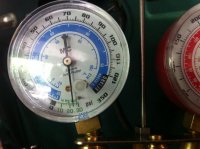I now have some R12 and want to test the AC. It hasn't worked for 10 years.
I understand from previous posts I should first evacuate the system with a vacuum pump and then determine if there are any leaks. Is there anything else I should do first before charging the system?
Also, I never worked on a R12 system. I have a 72 0cs with the original compressor. I don't even know which is the low (to charge the system) or high valve. Is the suction/low valve the one close to the fender and the high valve closer to the engine?
Would appreciate any suggestions.
Thanks
I understand from previous posts I should first evacuate the system with a vacuum pump and then determine if there are any leaks. Is there anything else I should do first before charging the system?
Also, I never worked on a R12 system. I have a 72 0cs with the original compressor. I don't even know which is the low (to charge the system) or high valve. Is the suction/low valve the one close to the fender and the high valve closer to the engine?
Would appreciate any suggestions.
Thanks
Last edited:


